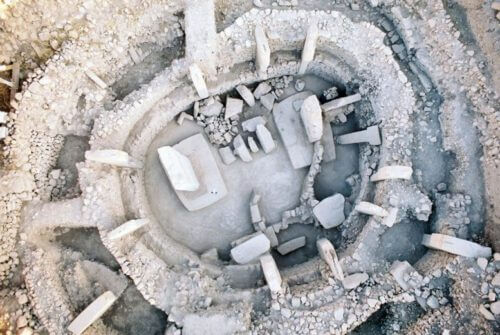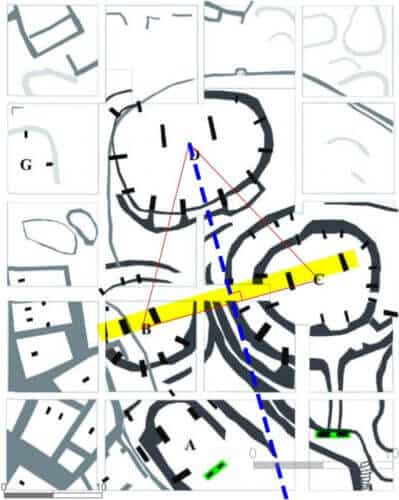Hunter-gatherers built the giant Gobkali Tepe temple 11,500 years ago in present-day Turkey as a single complex of ritual importance, Tel Aviv University researchers say
By: American Friends of Tel Aviv University (AFTAU), May 13, 2020
Translation: Ziv Adaki

Göbekli Tepe, the extensive 11,500-year-old site in southeast Antalya, Turkey, is the oldest temple in human history that we know of, and one of the most important discoveries in Neolithic research.
Researchers at Tel Aviv University and the Antiquities Authority have now used architectural analysis and discovered that a geometric plan underlies the impressive circular stone formations of Gobkali Tapa and its huge limestone columns. The temple, the researchers claim, was originally designed as a single unit.
Three of the monumental circular enclosures of Gobkali Tepe, the largest of which was 20 meters in diameter, were planned in advance as one project, according to researchers Gil Haklai of the Antiquities Authority, a doctoral student at Tel Aviv University, and Prof. Avi Gopher of the Department of Archeology and Ancient Near Eastern Civilizations at Tel Aviv University. They used an algorithm to identify aspects of the architectural planning processes that underlie the construction of these complexes at the Early Neolithic site.
In May 2020, their findings were published in the Cambridge Archaeological Journal.
"Gobkali Tepe is an archaeological wonder," explains Prof. Gopher. "It was built by Neolithic communities 11,000-11,500 years ago, it consists of huge circular stone complexes and monumental stone columns, rising to a height of 5.5 meters. Because there is no evidence of agriculture or domesticated animals at the site, it is believed that the site was built by hunter-gatherers, however, the architectural complexity of the site is not typical of them at all."

Geometric patterns reveal the architectural design of a complex in Gobkali Tepe. A diagram is placed on the scheme of the compound. Credit: Gil Khaklai/ AFTAU
Since the German archaeologist Dr. Klaus Schmidt discovered Gobkali Tepe in 1994, the site has been at the center of heated archaeological debates. However, while this site and other finds from the early Neolithic period have been studied vigorously, the subject of architectural planning in these periods and its heavy cultural implications has not yet been studied.
Most researchers claim that the complexes in the center of the excavation area at the Gobkali Tepe site were built over time. However, Khaklai and Prof. Gopher believe that three of these complexes were designed as one project and according to a cohesive geometric pattern.
"The plan of the three complexes is characterized by spatial and symbolic hierarchies, which reflect changes in the spiritual world and the social structure," explains Haklai. "In our research we used an analysis tool - an algorithm based on standard deviation mapping - to identify geometric patterns that organize the plan."
"This study revealed important information regarding the early development of architectural planning in the Levant and in the world in general," adds Prof. Gasper. "It opens up possibilities for new interpretations about the nature of the site in general and the nature of megalithic anthropomorphic columns specifically."
In the past, researchers believed that certain planning abilities and methods, such as the use of a geometric plan for floor planning, appeared long after the time when Gobkali Tepe was built - after the hunter-gatherers became food-growing farmers, about 10,500 years ago. It is worth noting, the use of right-angled architecture is one of the characteristics of the early farmers.
"This case of early architectural planning can serve as an example of the nature of cultural changes in the early stages of the Neolithic period," says Haklai. "Our findings show that fundamental architectural changes during this period, such as a shift to right-angled architecture, were knowledge-based, processes carried out by experts, from top to bottom.
"The most important and basic methods of architectural planning were invented in the Levant in the late Epipaleolithic period as part of the Natufian culture and onwards through the early Neolithic period. Our new research indicates that architectural design methods, abstract design laws, and organizational patterns were already in use during this formative period in human history."
The researchers plan to continue investigating architectural findings from other Neolithic sites throughout the Levant.
More of the topic in Hayadan:

4 תגובות
It's funny that a scientist puts up an article like this. In 2009, you brought a translation of a NASA researcher who cancels anything related to Govkaltapa. How fun that the pendulum is swinging in the direction of the truth.
Israeli researchers discovered ???
The site is located 15 km from Orpa, at the top of a ridge of limestone hills, which form the southeastern extension of the Taurus Mountains. The meaning of the name is "hill with navel". The mound rises to a height of 15 meters and its diameter is about 300 meters. It was discovered in 1963, in an archaeological survey conducted by a group of American and Turkish scientists. They came across several large, rectangular, shaped limestones, obviously man-made, sticking out of the ground. The researchers assumed that these were Byzantine tombs and did not continue the examination.
In 1994, Dr. Klaus Schmidt, a German archaeologist from the University of Heidelberg, read the reports compiled on the site and decided to travel to the area to examine the findings himself. Beginning in 1995, the Orpa Museum, the German Institute of Archeology (DAI) and researchers from the University of Karlsruhe conducted extensive excavations at the site led by Schmidt.
Well, it's Conan Temple.. you can see..
But the world hasn't existed for 5000 years? And he's also dishonest?